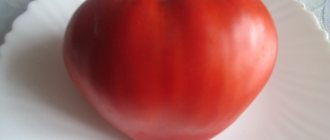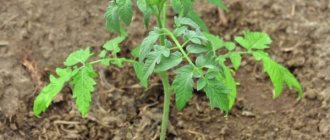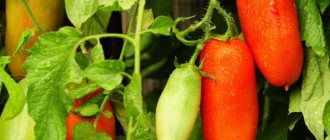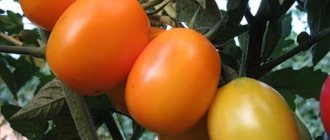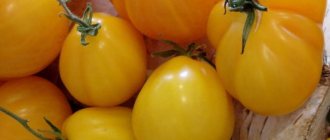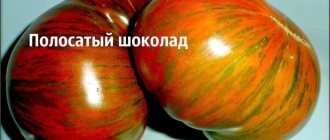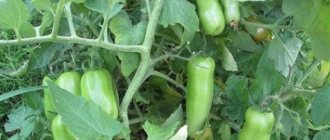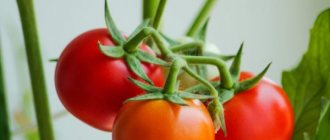A deep desire to plant and grow is inherent in all farmers. To help them, selection creates wonderful varieties, including the Vater Rhein tomato. This is a German variety, which is akin to high quality tomatoes and productivity.
| Height | Landing location | Ripening time | Fruit color | Fruit size | Origin | Fruit shape |
| Medium height | Greenhouse, Open ground | Mid-season | Reds | Large | Variety | Heart-shaped |
Description of the variety
The German tomato variety Vater Rhein (original name Vater Rhein, literally translated as “Father Rhein”) is included in the Gene Bank of the German Plant Institute. Leibniz. It is not included in the State Register of Selective Achievements of Russia.
Seeds are distributed mainly by amateur gardeners. On forums you often find information about the discrepancy between the characteristics declared by the manufacturer. The reason for this is misgrading or non-compliance with agricultural technology rules.
Tomatoes are grown in greenhouse conditions in regions with temperate climates and in open ground in the south of the country.
Pictured are Vater Rhein tomatoes.
Distinctive features
Features of culture:
- semi-determinate bushes up to 1.5 m high;
- foliage is scanty, leaves are thin, drooping, green;
- there are few stepchildren;
- 3–5 ovaries are formed on the fruit cluster;
- ripening period – 95–105 days;
- requires the formation of 2-3 stems;
- excellent keeping quality;
- the level of transportation is average;
- universal purpose in cooking.
Fruit characteristics:
- the shape is original, slightly ribbed, reminiscent of a heart with an elongated nose;
- the average weight of tomatoes is 200–300 g, the maximum is 1 kg;
- the color is red, without a dark spot;
- the pulp is sweet and sour, sugary and fleshy;
- pronounced tomato aroma;
- the skin is thin, glossy, smooth;
- the pulp retains its shape when cut and contains a minimum number of seeds;
- There are about six seed chambers, small in size.
Important ! To achieve the stated characteristics, tomatoes are left to ripen completely on the bushes.
Accurate information about the yield of the variety is not provided. According to the observations of farmers, on average, up to 5 kg can be harvested from one bush, and 15–20 kg of selected fruits from 1 m², subject to proper agricultural technology.
Harvesting and application
2–2.5 weeks before harvesting, all flower brushes and ovaries are torn off from the bushes. Tomatoes are harvested before the onset of cold weather due to the crop's susceptibility to putrefactive lesions.
Fully ripe tomatoes have an amazing rich taste and aroma. Suitable for fresh consumption, making pasta, juice, sauce, lecho and adjika.
To extend shelf life, the fruits are harvested at the stage of blanzhe ripeness (brown color).
The popularity of tomatoes in our country is explained by the fact that they can serve as ingredients for preparing various dishes. Take, for example, the Vater Rein variety, which is primarily ideal as a base for a salad of fresh vegetables. This sample of German origin is suitable for adding to borscht, stew, squeezing juice, creating sauce or ketchup. Suitable for canning for the winter. Well, in itself it is incomparable and useful.
Tomato "Ephemeral" is perhaps the most extraordinary variety of tomatoes. This ultra-early species requires virtually no maintenance. The hybrid plant can withstand both cold snaps and prolonged drought, while producing a huge number of high-quality tomatoes. Its fruits have a fantastic taste and can be used in various culinary experiments.
The “Ephemeral” variety was developed by domestic scientists. Thanks to their efforts, the hybrid received a lot of advantages and in a short time became the leader among hybrid varieties.
The first reason why Ephemera is so loved by summer residents is its ability to bear fruit in record time. The first medium-sized tomatoes are removed from the bush already 85-90 days after sowing.
Tip: to get the harvest earlier, it is recommended to grow tomatoes in a greenhouse.
Secondly, Ephemera plants are short-growing. The average height of the bush is 45-50 centimeters. In a greenhouse, the bushes reach up to 60 centimeters. The foliage is average. The leaves are small and rough to the touch.
READ MORE: Strawberry arosa variety description photo reviews from gardeners
However, the trunk of the plant is not very strong, and therefore it is better to tie up the bushes to avoid breaking the branches.
The fruits have a round shape. The skin is smooth, elastic and durable. At the stage of technical ripeness, the surface color is light green. Upon reaching biological maturity, the fruit turns rich red. The pulp is dense, fleshy, sweet. Fruit weight is 70-80 grams.
Thirdly, those who have tried Ephemera tomatoes at least once cannot forget the fantastic taste of the fruit. Their taste is very rich, sweetish-sour and with a bright tomato aroma. They are suitable for fresh consumption, as well as for pickling and preservation.
Tip: to get a bountiful harvest, remove excess shoots.
The Ephemeral variety is also highly resistant to various diseases.
Fourth: one of the obvious advantages of the hybrid is the unpretentiousness of its bushes to the abundance of sunlight. Even in regions where the sun rarely peeks through the clouds and daytime temperatures leave much to be desired, Ephemera plants will bear well and impart an unusual taste to the fruits.
The ephemeral is also a high-yielding variety. From one square meter, on which 4-5 plants are placed, 10-11 kilograms of medium-sized tomatoes are usually harvested.
In the southern regions, this feature is widely practiced, harvesting in June and August.
Advantages of the variety:
- very early fruit ripening;
- excellent tomato taste;
- simultaneous fruiting;
- the ability to get two harvests per summer;
- fruits are well stored and tolerate transportation;
- immunity against all diseases;
- universal purpose of fruits.
The uniqueness of the Ephemer variety is that tomatoes can be grown both through seedlings and seeds (in a greenhouse). The germination rate of the seed is high, which ensures a large number of seedlings.
There is no need to rush to sow seeds for seedlings and burden yourself with these troubles in February and early March. Since the variety is super early, tomatoes begin to ripen very early, already in June. So it is better to sow seeds in the last ten days of March or even in early April.
Just like other varieties and hybrids, Ephemera seeds must undergo pre-planting preparation. Its essence is to first disinfect the seeds by soaking them in a weak manganese solution.
Such treatment will contribute to the development of stable immunity of tomatoes against many diseases that can affect young seedlings.
To improve the growth process of strong, strong plants, various growth stimulants are used, which are sprinkled on the seeds.
Advice: if the soil is too heavy, you can add river sand to its composition.
The seeds are sown in shallow grooves, at a distance of two centimeters from each other. Afterwards, the crops are sprinkled with soil and carefully watered again.
Gardeners recommend covering the box with film before germination and placing the seedlings in a place where they will receive the maximum amount of sunlight. Hybrid varieties grow well at elevated temperatures, so you need to take care of this aspect as well. It is optimal for the seedlings to be kept in a room where the air is heated to 28 degrees Celsius.
A greenhouse effect occurs under the film, which means the humidity of this space is increased. To avoid stagnation of moisture on the ground, and accordingly not to cause the spread of fungal diseases, seedlings need to be ventilated.
Planting in open ground is carried out in the last days of May or even at the beginning of June (planted in a greenhouse in early May). The right time for transplantation is when the weather becomes warm and the soil warms up to 10 degrees Celsius.
In order for the seedlings to take root better after transplantation, they are hardened off two weeks before planting in the garden. The temperature in the room is gradually lowered.
The seedlings are taken out to the veranda every day so that they get used to unusual street conditions.
Landing in the ground
Since Ephemera plants are of the parthenocarpic type, that is, they do not require pollination, they can be safely planted in a greenhouse. Seedlings are planted 55-70 days after sowing the seeds. By this time, 4-6 leaves will appear on each bush.
Tomatoes love light and fertile soils. The more organic and mineral components in the soil, the faster the seedlings will take root and grow, set fruit well and bring the first harvest faster. Therefore, when planting a bed, you must add humus and superphosphate to the soil.
Tip: it is best to plant after beds with cucumbers, cabbage, legumes, onions, and carrots.
Each bush is placed in a specially prepared hole, which is also well flavored with complex fertilizer before planting. The distance between bushes should be 30-40 centimeters.
Tomatoes can grow in dense plantings, so the average number of bushes placed per square meter can reach nine pieces. After planting, the bed is left alone for 7-10 days so that the bushes can successfully take root in a new place and begin to grow.
Ephemeral tomatoes are surprising primarily because they do not need to be constantly looked after, spending a lot of time. Plants withstand drought, rain, and wind.
They do not mind severe waterlogging, and therefore fungal and viral infections never damage Ephemera bushes. They are not afraid of bacterial diseases either.
The only misfortune that can happen is an invasion of the Colorado potato beetle, from which no vegetable crop is immune. You can only save yourself from harmful insects with insecticidal preparations.
Formation
Ephemera bushes are determinate, low-growing, do not require formation. However, many summer residents argue that in order to get an earlier harvest, you still need to cut off the extra stepsons.
In addition, in order to achieve higher quality fruits, it is necessary to normalize the fruiting clusters. That is, you need to remove excess ovaries from them in order to free up the extra energy of the bush for the formation of larger and juicier fruits. If this is not done, the yield and quality of tomatoes will be significantly reduced.
Advice: don’t rush to throw away extra stepsons. You can grow excellent seedlings from distant shoots and plant them in the ground at the end of June.
Ephemeral varieties are also not demanding when it comes to watering plants. Yes, tomatoes love water, but they can survive several days of drought without damaging the crop. In addition, a distinctive feature of the variety is that even in the rainiest season the bushes will produce a good harvest. Thanks to this characteristic, the Ephemer variety is easy to grow in any region of Russia, without fear of losing the harvest due to bad weather.
You need to water your tomatoes with warm water two to three times a week. It is better to pour water directly under the bush, without touching the leaves, stems and fruits.
It is important to prevent cracking of the soil and its compaction, due to which moisture and air do not penetrate well into the depths, which means that the roots do not receive enough adequate nutrition. Therefore, after each watering, the soil under the bushes and even between the rows needs to be loosened.
Mulching works best for tomato plantings. Mulch is a layer of sawdust, straw or grass, which is laid out under each bush up to 5-7 centimeters thick.
Agricultural technology of tomatoes
The Vater Rein variety is distinguished by its demands on lighting and nutrition. Otherwise, caring for the plant is no different from cultivating other tomatoes and involves moderate watering, fertilizing, loosening the soil and weeding.
Preparing the soil and sowing seeds
The crop is grown through seedlings. Sowing begins 55–60 days before planting in the ground. The soil is prepared independently from a mixture of black soil, peat and sand in a ratio of 1:1:1. 40 g of superphosphate is added to a bucket of substrate, then disinfected in the oven, steamed or using a concentrated solution of potassium permanganate.
The seeds are soaked in a slightly pink solution of potassium permanganate for 30–40 minutes and washed with running water. Some gardeners recommend pre-sprouting the grains. To do this, they are laid out in gauze, folded in 2-3 layers, and watered. The fabric is placed in a bowl, covered with cling film on top and left in a warm place for 24 hours. The seeds will “wake up” in 3–5 days at a temperature of +23 °C.
The seedling boxes are filled with moist soil and the grains are sown to a depth of 1.5–2 cm at a distance of 2 cm from each other. A film is stretched over the top or glass is placed. Sprouts appear at an air temperature of +22 ° C in 4–6 days.
Land for seedlings of tomatoes, peppers and eggplants
Growing seedlings
After the seeds hatch, the covering is removed and the boxes are taken out to a sunny place. The air temperature should be +15 °C. This is necessary to strengthen the protective forces of the seedlings. After a week, the air temperature is gradually increased to +24 °C.
Water moderately, as the top layer dries, using a sprayer. Excess moisture leads to rotting of the root system.
Picking into individual pots is carried out after the appearance of 3-4 leaves.
Gardeners note that Vater Rein seedlings look weak compared to seedlings of other tomatoes and need sufficient lighting. When there is a shortage of sunlight, fluorescent lamps are used. The normal daylight hours are 16 hours.
Fertilizing with ready-made fertilizers “Agricola”, “Siyanie”, “Effecton” helps to strengthen the seedlings.
Landing
The place for planting seedlings is chosen on the south side of the site. This applies to both indoor and open ground.
Before moving the seedlings to a permanent location, it is advisable to make sure that there is no threat of night frosts. The soil temperature should not be lower than +16 °C.
The soil on the site is prepared in the fall: it is dug up, weeds with roots are removed, and fertilized with humus (1 10 liter bucket per 1 m²). In spring, the soil is loosened and humus is added (10 liters per 1 m²).
Tomatoes grow faster in an area where cabbage, onions, beans or peas were previously cultivated. It is not recommended to use soil in which eggplants, tomatoes, and bell peppers grew. This is the main principle of crop rotation.
Seedlings are planted from the beginning to the end of May. Planting density is 3-4 bushes per 1 m². The arrangement of bushes is 30×40 cm.
The holes are dug to a depth of 20 cm and filled with boiling water. The seedlings are watered abundantly with warm water and planted in holes. Wooden stakes are dug in nearby and bushes are tied to them after a week.
Care
Rules of care:
- Plants shoot and form 2-3 stems for abundant fruiting. Formation into 1 stem allows you to grow giant fruits weighing up to 1 kg.
- To strengthen the bushes, hilling is carried out - 2-3 times during the growing season.
- Plants are tied up every 14–20 days.
- Moderate watering - 1-2 times a week, 1 liter of rain or settled water for each bush in the evening.
- They loosen and weed every week.
Advice. Cover the soil with mulch (agrofibre, sawdust, pine needles, hay) to prevent weed growth and moisture retention.
Tomatoes are fed 3-4 times during the growing season:
- The first feeding is mineral-organic, 10 days after planting the seedlings (10 g of superphosphate, 10 l of mullein solution).
- Subsequent feeding - with mineral compounds every two weeks (10 g of diammofoska per 10 liters of water). The solution is enough to water 1 m².
Ready-made mineral complexes - “Kemira Lux”, “Tsitovit”, “Rastvorin” - replenish the lack of phosphorus, potassium, zinc, magnesium, manganese, and accelerate the ripening of tomatoes. They are used once every 14 days for foliar feeding.
Diseases and pests
Tomato Vater Rhine rarely suffers from viral diseases (verticillium and fusarium), but is prone to late blight and blossom end rot.
Signs of late blight infection:
- brown spots with a gray tint on stems and leaves;
- white coating on the back of the leaves;
- deformation of tomatoes.
Fighting methods:
- prevention (soil treatment with copper sulfate, moisture control, timely fertilizing with phosphorus and potassium);
- spraying with “Ridomil”, “Quadris”, “Acrobat”, “Agate”, “Fundazol”.
Signs of blossom end rot:
- depressed spots on the crown of the fruit of a green hue, which become brown and then black as the disease progresses;
- cracks in the skin;
- wrinkling of tomatoes;
- the pulp begins to rot.
Fighting methods:
- preventive disinfection of seeds with potassium permanganate;
- adding chalk to the soil (50 g per 1 m²);
- foliar feeding with potassium (10 g of calcium nitrate per 10 liters of water, 500 ml per 10 m²);
- mulching with nettles, straw, white agrofibre;
- ventilation of greenhouses.
Tomatoes are a favorite delicacy of aphids, wireworms, mole crickets and whiteflies. Insecticides “Grom”, “Force”, “Fitoverm”, “Epin” help fight pests.
Folk remedies are no less effective:
- Pour 100 g of onion peels into 1 liter of warm water. Leave for 10–12 hours and add 25 ml of liquid soap. Irrigate the bushes once every 7 days.
- Boil 3 kg of fresh wormwood in 10 liters of water for 30 minutes. Cool and use for spraying tomatoes once every 7 days.
- Mix 150 g of hot pepper, 10 liters of water, 400 ml of table vinegar. To combat mole crickets, leave the mixture for 24 hours and pour 0.5 liters into the hole.
Tomato Vater Rein, reviews from summer residents, characteristics of the variety, planting and care
Tomatoes are one of the most popular types of vegetables in our country. Every year, summer residents and vegetable growers grow various types of tomatoes on their plots in order to find a favorite variety that they can show off to their neighbors every year, enjoy the bright taste and replenish their stocks of canned food and preparations for the winter.
Vater Rhein, “Father Rhein” (original name Vater Rhein) is an interesting variety for the middle zone. According to its characteristics, the Vater Rein tomato is characterized by high yield and has an unusual heart-shaped shape with a small number of seeds in the fruit.
This variety was obtained through selection in Germany. The bush is medium in height, about 150 cm, mid-season, with insignificant foliage, with thin elongated leaves. It is advisable to form a bush with 2 or 3 stems to obtain maximum yield, but when decorated with 1 stem, the tomatoes turn out to be large, up to 1 kg.
The fruit is beautifully heart-shaped with a thin small nose, bright red. Tomato Vater Rein looks impressive in the photo. The fruits are average in weight 400 - 600 g, sweet, with juicy and dense pulp. Intended use: fresh, but also suitable for making juices and various sauces.
READ MORE: Manan for diarrhea is possible or not contraindications
Caring for Vater Rein is not much different from growing other semi-determinate varieties. The only difference is the requirements for power and lighting.
Any universal soil from the store is suitable for sowing seeds, or you can make it yourself by mixing coarse sand and peat in equal proportions. Before sowing, the soil is moistened, and the seeds are treated for higher germination and protection from diseases with a solution of potassium permanganate.
The seed material is evenly distributed over the surface and lightly sprinkled with soil. Cover the container with glass or plastic film and place it in a warm place (up to 23 degrees). After the first shoots appear (after 2 weeks), the film or glass is removed and the temperature is lowered to 10-15 degrees. Watering from a spray bottle is carried out as the soil dries.
Summer residents add organic matter to the soil and dig up the area. In spring, the soil is loosened and mineral fertilizers are applied right before transplanting. The plant loves neutral, loose and fertilized soil.
The best predecessors are cucumbers and onions, and not the recommended ones - bell peppers or eggplant. The seedlings are planted in rows with a distance of about 35-45 cm in a well well-watered hole.
Loosening and removal of weeds is carried out at least once every 2-3 weeks to fully saturate the root system with oxygen.
Hilling up takes place in stages. The first hilling is carried out a week after transplantation. The soil is thoroughly watered beforehand. The second hilling is done after 2-3 weeks.
On average, about a liter of water at room temperature is consumed to water one bush. It is best to water on cloudy days and in the evening after sunset.
Feeding is carried out 3–4 times per season. The first (mineral-organic) should be done 10-12 days after planting. Most often, mullein solution and superphosphate are mixed.
The following are done at intervals of 14-15 days with mineral mixtures.
Bushes require garters to a support (stakes or a stretched rope). Pinching, removing the top of a stem, gives the greatest yield when a bush is formed with 2-3 stems or with 1 stem, but with 2-3 tassels.
The most common diseases are:
- late blight;
- septoria;
- crown rot;
- macrosporiosis.
Approximately 20-25 days before the scheduled date, all buds and flowering brushes are removed from the plants. Fruit harvesting is carried out until the temperature at night drops below 9 degrees due to the susceptibility of the fruit to various diseases.
For long shelf life, tomatoes are harvested while still brown.
Having studied a large number of reviews about the German tomato variety Vater Rhein on the forums, we can draw an unambiguous conclusion about its popularity and high taste. Many vegetable growers have remained faithful to this variety for many seasons and always plant Vater Rein bushes in the greenhouse.
Summer residents note a large number of positive aspects:
- Medium and medium-early ripeness.
- Spectacular appearance of the fruit.
- Fleshy sweet pulp with sourness.
- Small number of seeds.
- Easy to care for.
- Universal use.
With proper care and following the basic rules of agricultural technology, you can get a rich harvest of tomatoes of this variety, and surprise your family and friends with the unusual appearance of the tomato and its wonderful taste. Unpretentious in care and high-yielding, it will definitely not leave any vegetable lover indifferent.
The nuances of growing in open ground and in a greenhouse
The Vater Rein variety is generally not capricious; it responds gratefully to fertilizing. Gardeners advise fertilizing tomatoes once every seven days. Slender bushes do not become fattened compared to heavily leafy tomatoes.
When cultivating in a greenhouse, it is necessary to control the humidity level. Excess leads to late blight and brown spot.
The crop reacts painfully to a sharp drop in temperature, so in the middle zone it is recommended to grow tomatoes in greenhouses. In the south, in open ground, there may be a decrease in yield during drought. In such cases, increase the frequency of watering.
How to grow tomatoes outdoors
Reviews
Vater Rein tomatoes receive rave reviews, primarily because of their excellent taste.
Irina, Bryansk: “I planted the tomatoes in a greenhouse, in the best place. I was afraid that the frail seedlings would not survive after the transfer. But in fact, the variety turned out to be the most productive of all. The fruits are just like in the picture: bright, plump, with a long tail. I watered it once a week and fed it with ready-made Kemira fertilizer. I picked fully ripe tomatoes. These are the most delicious."
Anatoly, Vyksa: “The most delicious tomatoes in my garden are Vater Rein. Interesting heart-shaped shape, sweet, aromatic flesh, relative ease of care - that’s why I love them so much. I grow it in a film greenhouse, I try not to overwater and fertilize it on time. I pick the fruits before the cold weather.”
